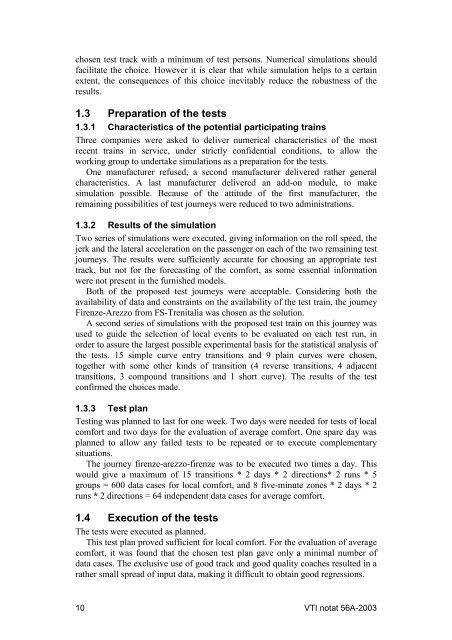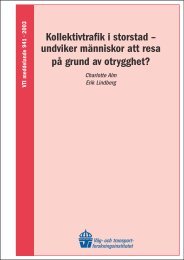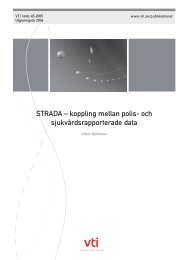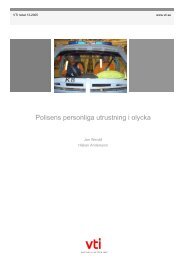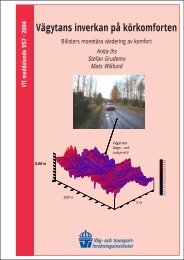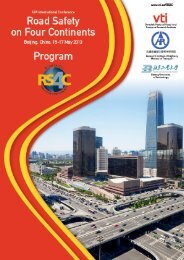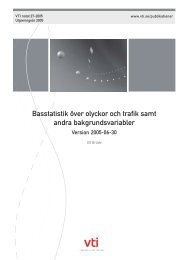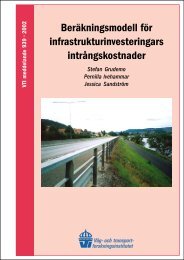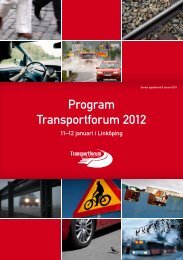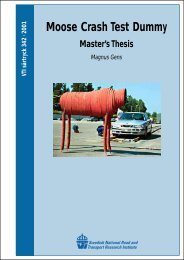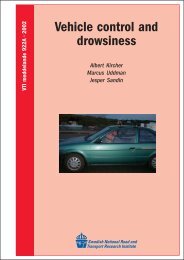UIC comfort tests - VTI
UIC comfort tests - VTI
UIC comfort tests - VTI
You also want an ePaper? Increase the reach of your titles
YUMPU automatically turns print PDFs into web optimized ePapers that Google loves.
chosen test track with a minimum of test persons. Numerical simulations shouldfacilitate the choice. However it is clear that while simulation helps to a certainextent, the consequences of this choice inevitably reduce the robustness of theresults.1.3 Preparation of the <strong>tests</strong>1.3.1 Characteristics of the potential participating trainsThree companies were asked to deliver numerical characteristics of the mostrecent trains in service, under strictly confidential conditions, to allow theworking group to undertake simulations as a preparation for the <strong>tests</strong>.One manufacturer refused, a second manufacturer delivered rather generalcharacteristics. A last manufacturer delivered an add-on module, to makesimulation possible. Because of the attitude of the first manufacturer, theremaining possibilities of test journeys were reduced to two administrations.1.3.2 Results of the simulationTwo series of simulations were executed, giving information on the roll speed, thejerk and the lateral acceleration on the passenger on each of the two remaining testjourneys. The results were sufficiently accurate for choosing an appropriate testtrack, but not for the forecasting of the <strong>comfort</strong>, as some essential informationwere not present in the furnished models.Both of the proposed test journeys were acceptable. Considering both theavailability of data and constraints on the availability of the test train, the journeyFirenze-Arezzo from FS-Trenitalia was chosen as the solution.A second series of simulations with the proposed test train on this journey wasused to guide the selection of local events to be evaluated on each test run, inorder to assure the largest possible experimental basis for the statistical analysis ofthe <strong>tests</strong>. 15 simple curve entry transitions and 9 plain curves were chosen,together with some other kinds of transition (4 reverse transitions, 4 adjacenttransitions, 3 compound transitions and 1 short curve). The results of the testconfirmed the choices made.1.3.3 Test planTesting was planned to last for one week. Two days were needed for <strong>tests</strong> of local<strong>comfort</strong> and two days for the evaluation of average <strong>comfort</strong>. One spare day wasplanned to allow any failed <strong>tests</strong> to be repeated or to execute complementarysituations.The journey firenze-arezzo-firenze was to be executed two times a day. Thiswould give a maximum of 15 transitions * 2 days * 2 directions* 2 runs * 5groups = 600 data cases for local <strong>comfort</strong>, and 8 five-minute zones * 2 days * 2runs * 2 directions = 64 independent data cases for average <strong>comfort</strong>.1.4 Execution of the <strong>tests</strong>The <strong>tests</strong> were executed as planned.This test plan proved sufficient for local <strong>comfort</strong>. For the evaluation of average<strong>comfort</strong>, it was found that the chosen test plan gave only a minimal number ofdata cases. The exclusive use of good track and good quality coaches resulted in arather small spread of input data, making it difficult to obtain good regressions.10 <strong>VTI</strong> notat 56A-2003


